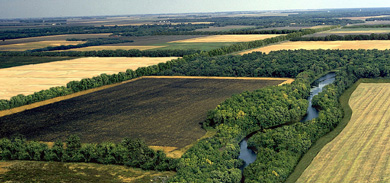Conservation Buffers

Description
Conservation buffers are small areas or strips of land in permanent vegetation, designed to intercept pollutants and manage other environmental concerns.
Strategically placed buffer strips in the agricultural landscape can effectively mitigate the movement of sediment, nutrients, and pesticides within farm fields and from farm fields. When coupled with appropriate upland treatments, including crop residue management, nutrient management, integrated pest management, winter cover crops, and similar management practices and technologies, buffer strips should allow farmers to achieve a measure of economic and environmental sustainability in their operations. Buffer strips can also enhance wildlife habitat and protect biodiversity.
Types of Buffers (CTIC, 1999)
- Contour Grass Strips/Cross-Wind Trap Strips: These rows of perennial vegetation strips can reduce wind. Generally, grass strips are planted with native, tall grasses while crosswind traps include shrubs and trees. The establishment of these buffers can protect young plants from wind damage, conserve moisture on the downwind side of the rows and reduce blowing soil.
- Field Borders: Vegetation planted in strips at the edge of fields. This area can be used for turn areas or travel lanes for machinery
- Filter Strips: Strips of grass or other vegetation used to slow water runoff from a field, these intercept or trap sediment, nutrients, pesticides, pathogens and other pollutants before they reach a river, lake or stream.
- Grass Waterways: These strips of grass are planted on areas of fields where water is concentrated as it runs through or off the fields. Used primarily to prevent and control gully erosion, waterways also act as a filter, trapping sediment and other pollutants.
- Living Snow Fence: Trees and/or shrubs planted to control drifting snow. This protects buildings, roads and other property from drifts. Living snow fences can also be used to help protect nearby areas for livestock, provide cover for wildlife and enhances soil moisture.
- Riparian Buffers: Streamside plantings of trees, shrubs and grasses that can intercept pollutants from both surface and shallow groundwater before they reach a river or stream. They provide habitat for wildlife and enhance fish habitat by, among other things, reducing water temperature.
- Shelterbelts/Windbreaks: This row or rows of trees and/or shrubs are used to reduce wind erosion, protect field crops and shelter livestock, wildlife and buildings from harsh weather.
- Salt-Tolerant Vegetation: In areas where salinity is a water issue, growers can plant vegetation capable of growing in high saline environments. If the correct vegetation is selected, it can, ultimately, help reduce saline seepage problems.
- Wellhead Protection Areas: By planting vegetation around public and private wells, landowners and managers can protect the well from contamination.
- Wetlands: These areas of shallow water are generally near or between cropland and lakes or streams. They have water loving grasses, shrubs, and/or trees growing in and around the area. In addition to acting as a filter and providing wildlife habitat, they can also reduce downstream flooding and replenish groundwater reserves.
Benefits of Buffers
Conservation buffers slow water runoff, trap sediment, and enhance infiltration within the buffer. Buffers also trap fertilizers, pesticides, pathogens, and heavy metals, and they help trap snow and cut down on blowing soil in areas with strong winds. In addition, they protect livestock and wildlife from harsh weather and buildings from wind damage. If properly installed and maintained, they have the capacity to:
- remove up to 50% or more of nutrients and pesticides.
- remove up to 60% or more of certain pathogens.
- remove up to 75% or more of sediment.
Conservation buffers reduce noise and odor. They are a source of food, nesting cover, and shelter for many wildlife species. Buffers also provide connecting corridors that enable wildlife to move safely from one habitat area to another. Conservation buffers help stabilize a stream and reduce its water temperature. Buffers also offer a setback distance for agricultural chemical use from water sources. Like the trim on a house makes the house look better, well planned conservation buffers improve the appearance of a farm or ranch. If used as part of a comprehensive conservation system, buffers will make good use of areas that often should not be cropped.
References
Buffer Strips: Common Sense Conservation. Natural Resources Conservation Service website
CTIC, 1999. What’s a Conservation Buffer? Conservation Technology Information Center.